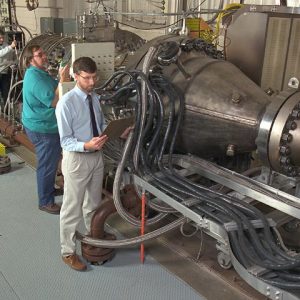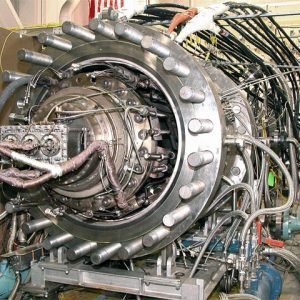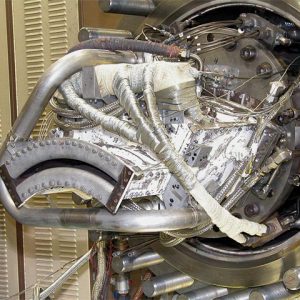Advanced Subsonic Combustion Rig
The Advanced Subsonic Combustion Rig (ASCR) is a unique high-pressure and high temperature combustor facility. It is significant because of its one-of-a kind ability to simulate combustor tests up to 60 atmospheres.
Facility Overview
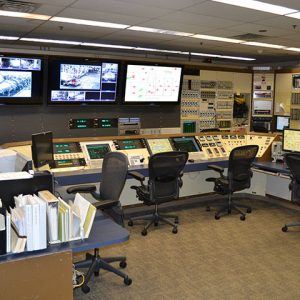
The Advanced Subsonic Combustion Rig (ASCR) at NASA’s Glenn Research Center (GRC) is a high-pressure, high-temperature combustion rig that simulates combustor inlet test conditions up to a pressure of 900 psig and temperatures up to 1300°F non-vitiated (no combustibles) at flow rates ranging from 5 to 50-lb/s. ASCR uses a dedicated high pressure compressor which pressurizes GRC’s centrally supplied 450 PSIG combustion air up to 900 PSIG, which is double the pressure capability of other combustor facilities at GRC. The maximum exhaust gas temperature from the test article is 3400°F.
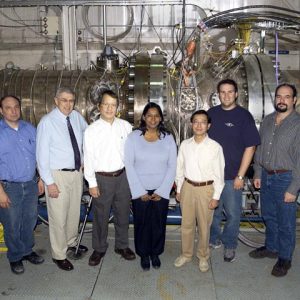
The ASCR has been instrumental to NASA and its industry partners in developing low emissions combustor technology at higher operating pressures. Research has focused on developing low NOx combustors for pressure ratios up to 55:1. The ability of ASCR to operate up to 60 atmospheres provides a unique capability for NASA and engine manufacturers to quantify the effects of higher pressure on combustor emissions, durability and operability.
Quick Facts
The ASCR is a high-pressure, high temperature combustion rig which simulates engine test conditions up to a pressure of 900 PSIG and a temperature of 1300°F non-vitiated (no combustibles) at 50 lb/sec air flow. The facility supports research on multiple fuel injector test hardware for large aircraft engine development, and full-scale annular combustor development for regional aircraft engine development.
| Inlet Pressure | 50-900 psig |
|---|---|
| Inlet Temperature | 250° to 1300°F (non-vitiated) |
| Inlet Airflow | 5 to 50 lb/sec |
| Exhaust | atmospheric or altitude |
| Facility Manager | Gwynn.A.Severt@nasa.gov |
- The ASCR has been instrumental in supporting low-emissions combustor research and development since October 1996.
- The ASCR has been instrumental in helping aviation industry develop combustor technologies to meet the industry’s 70 percent NOx emission reduction goals.
- The ASCR supports research on multiple fuel injector test hardware for large aircraft engine development, and full-scale annular combustor development for regional aircraft engines.
- The ASCR has supported NASA Combustor Emission Reduction programs, as well as tests for General Electric Aircraft Engines (GEAE), Rolls-Royce North America (RRNA) and Pratt & Whitney.
Capabilities
Features
- Inlet pressure: 50 to 900 psig
- Inlet temperature: 250 to 1300 °F
- Inlet airflow : 5 to 50 lb/s
- Exhaust: atmospheric
Stand 1 Sector Rig Capabilities
- Fuel Lines: 10
- Gas Analysis: 20 sample lines
- Pressure Measurements: 60 P taps
- Temperature Measurements: 96 Type K/12 Type B
- Ignition Source: spark igniter
Stand 2 Flametube Capabilities
- Fuel Lines: 4
- Gas Analysis: 2 sample lines
- Pressure Measurements: 60 P taps
- Temperature Measurements: 96 Type K/12 Type B
- Ignition Source: spark igniter
Other Features
- Dynamic Pressure Measurement
Contact
Advanced Subsonic Combustion Rig (ASCR)
Facility Manager: Gwynn Severt
216-433-8310
Gwynn.A.Severt@nasa.gov
Test Facility Management Branch
Branch Chief: Michael S. McVetta
216-433-2832
michael.s.mcvetta@nasa.gov
Using Our Facilities
NASA’s Glenn Research Center provides ground test facilities to industry, government, and academia. If you are considering testing in one of our facilities or would like further information about a specific facility or capability, please let us know.
Did you test in one of our facilities? Let us know about your experience by participating in our customer facility evaluation survey.

